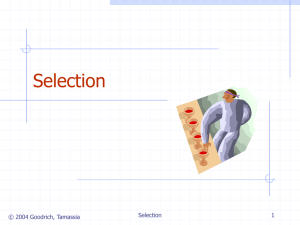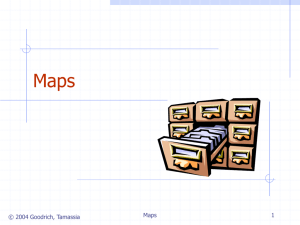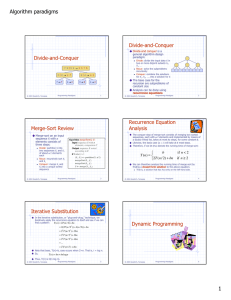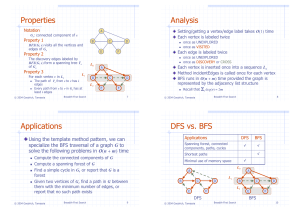Dynamic Programming Matrix Chain-Products An Enumeration Approach (not in book)
advertisement
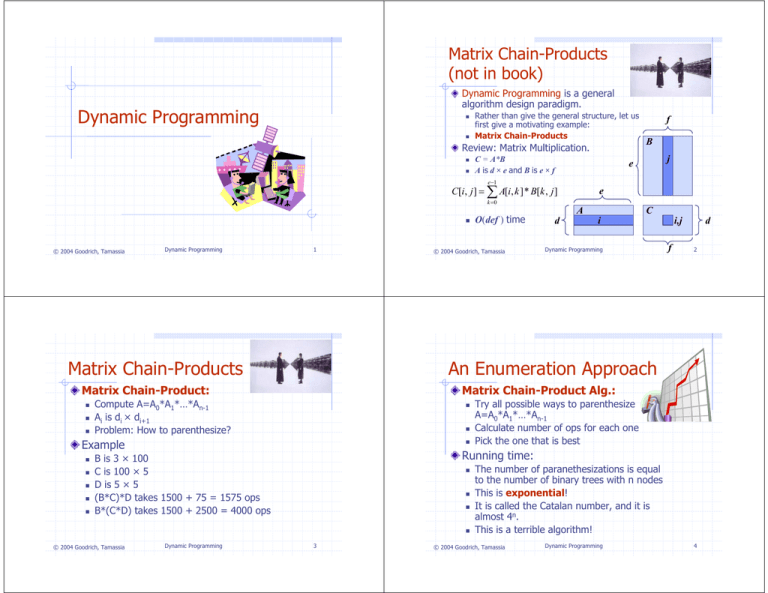
Matrix Chain-Products
(not in book)
Dynamic Programming is a general
algorithm design paradigm.
Dynamic Programming
Rather than give the general structure, let us
first give a motivating example:
Matrix Chain-Products
Review: Matrix Multiplication.
C = A*B
A is d × e and B is e × f
e −1
k =0
© 2004 Goodrich, Tamassia
Dynamic Programming
1
Matrix Chain-Products
Compute A=A0*A1*…*An-1
Ai is di × di+1
Problem: How to parenthesize?
Dynamic Programming
A
i
C
Dynamic Programming
i,j
f
d
2
Try all possible ways to parenthesize
A=A0*A1*…*An-1
Calculate number of ops for each one
Pick the one that is best
Running time:
B is 3 × 100
C is 100 × 5
D is 5 × 5
(B*C)*D takes 1500 + 75 = 1575 ops
B*(C*D) takes 1500 + 2500 = 4000 ops
© 2004 Goodrich, Tamassia
d
e
Matrix Chain-Product Alg.:
Example
© 2004 Goodrich, Tamassia
j
An Enumeration Approach
Matrix Chain-Product:
O(def ) time
B
e
C[i, j ] = ∑ A[i, k ] * B[k , j ]
f
3
The number of paranethesizations is equal
to the number of binary trees with n nodes
This is exponential!
It is called the Catalan number, and it is
almost 4n.
This is a terrible algorithm!
© 2004 Goodrich, Tamassia
Dynamic Programming
4
A Greedy Approach
Another Greedy Approach
Idea #1: repeatedly select the product that
uses (up) the most operations.
Counter-example:
Idea #2: repeatedly select the product that uses
the fewest operations.
Counter-example:
A is 10 × 5
B is 5 × 10
C is 10 × 5
D is 5 × 10
Greedy idea #1 gives (A*B)*(C*D), which takes
500+1000+500 = 2000 ops
A*((B*C)*D) takes 500+250+250 = 1000 ops
© 2004 Goodrich, Tamassia
Dynamic Programming
5
Define subproblems:
There has to be a final multiplication (root of the expression
tree) for the optimal solution.
Say, the final multiply is at index i: (A0*…*Ai)*(Ai+1*…*An-1).
Then the optimal solution N0,n-1 is the sum of two optimal
subproblems, N0,i and Ni+1,n-1 plus the time for the last multiply.
If the global optimum did not have these optimal
subproblems, we could define an even better “optimal”
solution.
© 2004 Goodrich, Tamassia
Dynamic Programming
© 2004 Goodrich, Tamassia
6
The global optimal has to be defined in terms of
optimal subproblems, depending on where the final
multiply is at.
Let us consider all possible places for that final multiply:
Find the best parenthesization of Ai*Ai+1*…*Aj.
Let Ni,j denote the number of operations done by this
subproblem.
The optimal solution for the whole problem is N0,n-1.
Subproblem optimality: The optimal solution can be
defined in terms of optimal subproblems
The greedy approach is not giving us the
optimal value. Dynamic Programming
A Characterizing
Equation
A “Recursive” Approach
A is 101 × 11
B is 11 × 9
C is 9 × 100
D is 100 × 99
Greedy idea #2 gives A*((B*C)*D)), which takes
109989+9900+108900=228789 ops
(A*B)*(C*D) takes 9999+89991+89100=189090 ops
7
Recall that Ai is a di × di+1 dimensional matrix.
So, a characterizing equation for Ni,j is the following:
N i , j = min{N i ,k + N k +1, j + d i d k +1d j +1}
i ≤k < j
Note that subproblems are not independent- - the
subproblems overlap.
© 2004 Goodrich, Tamassia
Dynamic Programming
8
A Dynamic Programming
Algorithm
A Dynamic Programming
Algorithm Visualization
Since subproblems
Algorithm matrixChain(S):
overlap, we don’t
use recursion.
Input: sequence S of n matrices to be multiplied
Output: number of operations in an optimal
Instead, we
paranethization of S
construct optimal
for i ← 1 to n-1 do
subproblems
“bottom-up.”
Ni,i ← 0
for b ← 1 to n-1 do
Ni,i’s are easy, so
start with them
for i ← 0 to n-b-1 do
j ← i+b
Then do length
2,3,… subproblems,
Ni,j ← +infinity
and so on.
for k ← i to j-1 do
Running time: O(n3)
Ni,j ← min{Ni,j , Ni,k +Nk+1,j +di dk+1 dj+1}
© 2004 Goodrich, Tamassia
Dynamic Programming
9
The General Dynamic
Programming Technique
Simple subproblems: the subproblems can be
defined in terms of a few variables, such as j, k, l,
m, and so on.
Subproblem optimality: the global optimum value
can be defined in terms of optimal subproblems
Subproblem overlap: the subproblems are not
independent, but instead they overlap (hence,
should be constructed bottom
- up).
© 2004 Goodrich, Tamassia
Dynamic Programming
j …
n-1
answer
Dynamic Programming
© 2004 Goodrich, Tamassia
10
Subsequences (§ 11.5.1)
Applies to a problem that at first seems to
require a lot of time (possibly exponential),
provided we have:
N i , j = min{N i ,k + N k +1, j + d i d k +1d j +1}
i ≤k < j
The bottom-up
N 0 1 2
construction fills in the
N array by diagonals
0
1
Ni,j gets values from
…
pervious entries in i-th
i
row and j-th column
Filling in each entry in
the N table takes O(n)
time.
Total run time: O(n3)
Getting actual
n-1
parenthesization can be
done by remembering
“k” for each N entry
11
A subsequence of a character string
x0x1x2…xn-1 is a string of the form
xi xi …xi , where ij < ij+1.
Not the same as substring!
Example String: ABCDEFGHIJK
1
2
k
Subsequence: ACEGJIK
Subsequence: DFGHK
Not subsequence: DAGH
© 2004 Goodrich, Tamassia
Dynamic Programming
12
The Longest Common
Subsequence (LCS) Problem
A Poor Approach to the
LCS Problem
Given two strings X and Y, the longest
common subsequence (LCS) problem is
to find a longest subsequence common
to both X and Y
Has applications to DNA similarity
testing (alphabet is {A,C,G,T})
Example: ABCDEFG and XZACKDFWGH
have ACDFG as a longest common
subsequence
© 2004 Goodrich, Tamassia
Dynamic Programming
13
A Dynamic-Programming
Approach to the LCS Problem
© 2004 Goodrich, Tamassia
Case 2:
Dynamic Programming
Enumerate all subsequences of X
Test which ones are also subsequences of Y
Pick the longest one.
Analysis:
If X is of length n, then it has 2n
subsequences
This is an exponential-time algorithm!
© 2004 Goodrich, Tamassia
Dynamic Programming
14
An LCS Algorithm
Define L[i,j] to be the length of the longest common
subsequence of X[0..i] and Y[0..j].
Allow for -1 as an index, so L[-1,k] = 0 and L[k,-1]=0, to
indicate that the null part of X or Y has no match with the
other.
Then we can define L[i,j] in the general case as follows:
1. If xi=yj, then L[i,j] = L[i-1,j-1] + 1 (we can add this match)
2. If xi≠yj, then L[i,j] = max{L[i-1,j], L[i,j-1]} (we have no
match here)
Case 1:
A Brute-force solution:
15
Algorithm LCS(X,Y ):
Input: Strings X and Y with n and m elements, respectively
Output: For i = 0,…,n-1, j = 0,...,m-1, the length L[i, j] of a longest string
that is a subsequence of both the string X[0..i] = x0x1x2…xi and the
string Y [0.. j] = y0y1y2…yj
for i =1 to n-1 do
L[i,-1] = 0
for j =0 to m-1 do
L[-1,j] = 0
for i =0 to n-1 do
for j =0 to m-1 do
if xi = yj then
L[i, j] = L[i-1, j-1] + 1
else
L[i, j] = max{L[i-1, j] , L[i, j-1]}
return array L
© 2004 Goodrich, Tamassia
Dynamic Programming
16
Visualizing the LCS Algorithm
Analysis of LCS Algorithm
We have two nested loops
The outer one iterates n times
The inner one iterates m times
A constant amount of work is done inside
each iteration of the inner loop
Thus, the total running time is O(nm)
Answer is contained in L[n,m] (and the
subsequence can be recovered from the
L table).
© 2004 Goodrich, Tamassia
Dynamic Programming
17
© 2004 Goodrich, Tamassia
Dynamic Programming
18
